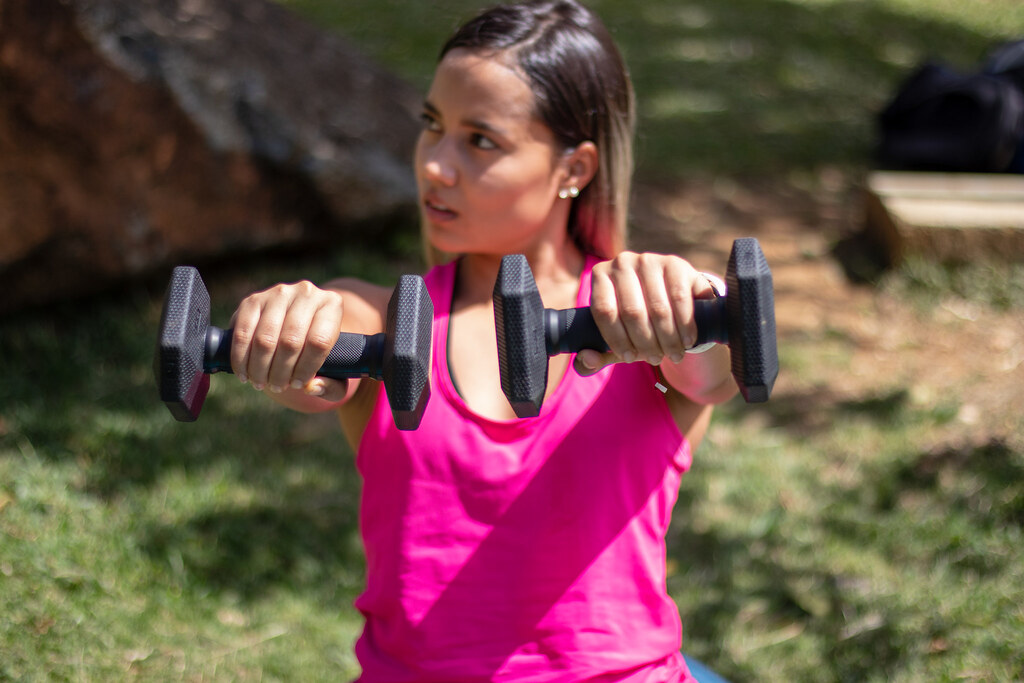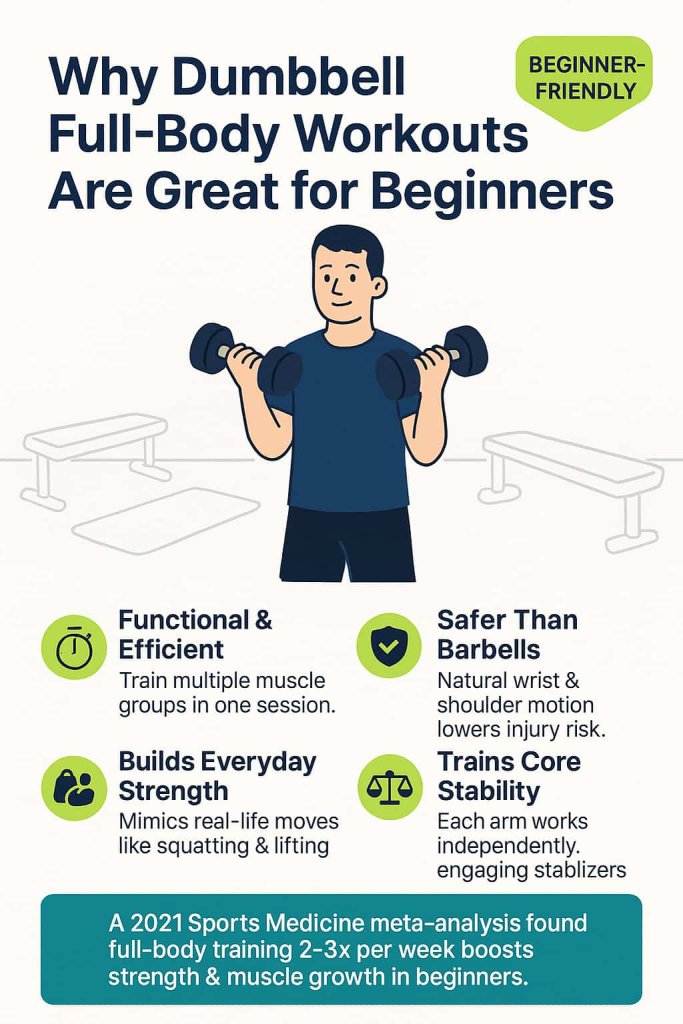The best full-body dumbbell workouts for beginners combine simple, compound movements that strengthen every major muscle group while improving balance and mobility. They’re easy to follow, beginner-safe, and backed by scientific research and certified trainers.

Whether you’re training at home or in a gym, dumbbells provide a powerful way to build total-body strength without needing a barbell, machines, or advanced skills. In this guide, you’ll discover 15 of the most effective exercises, how to structure them into full-body sessions, and the best practices for form, rest, and progression.
Why Dumbbell Full-Body Workouts Are Great for Beginners

Functional & Efficient
Full-body dumbbell training activates multiple muscle groups in one session. You get more results in less time.
A 2021 meta-analysis in Sports Medicine found that full-body resistance training 2–3 times per week significantly improves muscle hypertrophy and strength in beginners. (PMC)
Builds Everyday Strength
Many dumbbell moves are “functional,” meaning they mimic real-life activities like squatting, lifting groceries, or climbing stairs.
Safer Than Barbells
Dumbbells allow natural wrist and shoulder movement, reducing injury risk—especially important for beginners.
Trains Core Stability
Because each arm works independently, dumbbells improve balance and train stabilizer muscles better than machines.
15 Best Dumbbell Exercises for Beginners (Trainer-Approved & Science-Backed)
These exercises were chosen for their effectiveness, safety, and scalability. Start with light weights (5–15 lbs) and focus on form before increasing resistance.
1. Goblet Squat
Muscles Worked: Quads, Glutes, Core
Why It’s Great: This is the ultimate squat for beginners. Holding a dumbbell at chest height teaches proper squat form, engages the core, and protects the lower back.
How to Do It:
- Hold a dumbbell vertically with both hands under the top weight (like a goblet).
- Stand with feet slightly wider than shoulder-width, toes turned slightly out.
- Brace your core and keep your chest lifted.
- Push your hips back and bend your knees to descend until thighs are parallel to the ground.
- Keep your elbows inside your knees and knees tracking over toes.
- Drive through your heels to stand back up.
Trainer Tip: Brace your abs hard at the bottom. Think “lift with your legs, not your back.”
2. Romanian Dumbbell Deadlift (RDL)
Muscles Worked: Hamstrings, Glutes, Lower Back
Why It’s Great: A foundational hip-hinge movement that enhances posterior strength and flexibility.
How to Do It:
- Stand tall, holding dumbbells in front of your thighs with a neutral grip.
- Soften the knees slightly.
- Hinge at the hips, pushing your glutes backward as you lower the weights.
- Keep your back flat and dumbbells close to your legs.
- Lower until you feel a strong stretch in your hamstrings (typically mid-shin).
- Drive your hips forward to stand tall.
Trainer Tip: Don’t think “bend over.” Think “push your hips back.”
3. Dumbbell Chest Press (Bench or Floor)
Muscles Worked: Chest, Triceps, Shoulders
Why It’s Great: Builds upper-body pressing strength without needing a barbell or heavy equipment.
How to Do It:
- Lie flat on a bench or floor with dumbbells over your chest.
- Start with arms extended and palms facing forward.
- Slowly lower the dumbbells until elbows are just below shoulder level.
- Press back up to full extension.
Trainer Tip: Control the descent—don’t bounce the weights off the floor or let your elbows flare.
4. One-Arm Dumbbell Row
Muscles Worked: Back (Lats), Biceps
Why It’s Great: Strengthens pulling muscles and corrects side-to-side imbalances.
How to Do It:
- Place your left knee and hand on a bench.
- Hold a dumbbell in your right hand, arm fully extended.
- Pull the dumbbell toward your hip, squeezing your shoulder blade.
- Lower with control and repeat, then switch sides.
Trainer Tip: Don’t yank. Use your back, not momentum.
5. Dumbbell Overhead Press
Muscles Worked: Shoulders, Triceps
Why It’s Great: Builds deltoid strength and promotes upper-body posture.
How to Do It:
- Hold a dumbbell in each hand at shoulder height.
- Keep palms facing forward and wrists aligned.
- Press both dumbbells straight up until arms are fully extended.
- Slowly lower back down to the starting position.
Trainer Tip: Avoid arching your back—tighten your core to stay tall and strong.
6. Dumbbell Reverse Lunge
Muscles Worked: Glutes, Quads, Hamstrings
Why It’s Great: Unilateral strength training that also improves balance and coordination.
How to Do It:
- Hold dumbbells at your sides, feet hip-width apart.
- Step one leg backward, lowering until your front thigh is parallel.
- Keep chest lifted and torso upright.
- Push through your front heel to return.
- Alternate legs.
Trainer Tip: A narrow stance can affect balance—step wide enough for stability.
7. Dumbbell Side Lunge
Muscles Worked: Glutes, Inner Thighs, Adductors
Why It’s Great: Encourages lateral movement and strengthens neglected inner thigh muscles.
How to Do It:
- Stand tall with dumbbells at your sides.
- Step out to the side, bending one knee and keeping the opposite leg straight.
- Keep your back flat and chest lifted.
- Push through the heel to return.
Trainer Tip: Don’t let the knee collapse inward—track it in line with your foot.
8. Dumbbell Front Squat
Muscles Worked: Quads, Core, Upper Back
Why It’s Great: Emphasizes the quads and challenges posture and core engagement.
How to Do It:
- Hold dumbbells on your shoulders, elbows lifted in front.
- Keep the chest upright and core braced.
- Squat down, pushing knees out and hips back.
- Drive through your heels to stand up.
Trainer Tip: Keep elbows high to maintain dumbbell stability and upright posture.
9. Dumbbell Renegade Row
Muscles Worked: Core, Upper Back, Shoulders
Why It’s Great: Combines core stability with back and arm strength.
How to Do It:
- Begin in a push-up plank position with hands gripping dumbbells.
- Row one dumbbell toward your ribcage, keeping hips square.
- Lower and repeat on the other side.
Trainer Tip: Widen your feet for balance and avoid rotating your hips.
10. Dumbbell Deadlift to Curl to Press
Muscles Worked: Full Body
Why It’s Great: A compound, time-saving movement for full-body conditioning.
How to Do It:
- Perform a dumbbell deadlift.
- As you stand up, curl the weights to shoulder height.
- Press overhead.
- Reverse the motion with control.
Trainer Tip: Flow from one move to the next—don’t pause between stages.
11. Dumbbell Suitcase Carry
Muscles Worked: Core, Obliques, Grip, Forearms
Why It’s Great: Teaches anti-lateral flexion and improves real-world strength.
How to Do It:
- Hold a dumbbell in one hand at your side.
- Walk 20–30 seconds while keeping shoulders level.
- Switch sides.
Trainer Tip: Imagine balancing a glass of water on your head to stay upright.
12. Dumbbell Russian Twists
Muscles Worked: Obliques, Core
Why It’s Great: Builds rotational strength and core endurance.
How to Do It:
- Sit with knees bent, heels slightly off the ground.
- Hold a dumbbell with both hands.
- Twist torso and touch the dumbbell to the floor beside each hip.
Trainer Tip: Don’t just swing your arms—rotate through the core.
13. Dumbbell Thruster
Muscles Worked: Legs, Shoulders, Core
Why It’s Great: Combines lower-body power with upper-body pressing for high-intensity work.
How to Do It:
- Hold dumbbells at shoulders.
- Perform a full squat.
- Explosively stand and press dumbbells overhead in one fluid motion.
Trainer Tip: Use the momentum of your squat to launch the press.
14. Dumbbell Hip Thrust
Muscles Worked: Glutes, Hamstrings
Why It’s Great: Superior for isolating and growing glute muscles.
How to Do It:
- Sit on the floor with upper back against a bench.
- Roll a dumbbell onto your hips.
- Drive hips up, squeeze glutes at the top.
- Lower under control.
Trainer Tip: Pause at the top for a stronger contraction.
15. Dumbbell Woodchopper
Muscles Worked: Core, Shoulders, Obliques
Why It’s Great: Enhances rotational and diagonal movement patterns.
How to Do It:
- Hold a dumbbell with both hands above one shoulder.
- Twist and chop down across your body to the opposite hip.
- Reverse to starting position.
- Repeat and switch sides.
Trainer Tip: Keep the motion smooth and controlled—don’t just swing the weight.
Full-Body Dumbbell Workout Routine (2 Options)
Perform 2–3 full-body sessions per week, alternating between Workout A and Workout B.
Workout A
- Goblet Squat – 3×10
- Dumbbell Chest Press – 3×8
- One-Arm Row – 3×10 per side
- Reverse Lunge – 3×8 per leg
- Renegade Row – 3×8
- Russian Twists – 3×15
Workout B
- Romanian Deadlift – 3×10
- Overhead Press – 3×10
- Side Lunge – 3×10 per leg
- Thruster – 3×8
- Dumbbell Woodchopper – 3×10 per side
- Suitcase Carry – 30 sec per side × 3
Finisher Option: Deadlift to Curl to Press × 10 reps
How to Warm Up Before Lifting
- Jumping jacks or high knees – 1–2 minutes
- Arm circles, shoulder rolls
- Bodyweight squats and hip openers
- 10 reps of each dumbbell move using light or no weight
Progression Tips (Science-Backed)
- Increase weight every 2–3 weeks if all reps are easy
- Add sets or reps
- Reduce rest time gradually (from 90 to 60 seconds)
- Track your reps, sets, and weights weekly
Research confirms progressive overload is key for strength and hypertrophy gains. (BuiltWithScience)
FAQs
Can beginners really get strong with just dumbbells?
Yes! Dumbbells are effective for building total-body strength and muscle when used consistently with proper form and progressive overload.
How often should I do this workout?
Start with 2 sessions per week, then increase to 3 as you adapt and recover faster.
How long does each session take?
Each full-body workout takes around 30–45 minutes including warm-up and rest time.
Can I do this at home?
Absolutely. You only need 1–2 pairs of dumbbells and enough space for lunges or floor work.
Conclusion
This 15-exercise full-body dumbbell plan is your foundation for long-term strength and confidence. It’s simple, science-backed, and approved by trainers. Stick to it 2–3 times weekly for 8 weeks and you’ll see noticeable improvements in strength, posture, and endurance.
